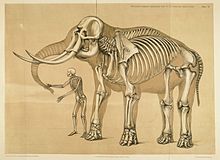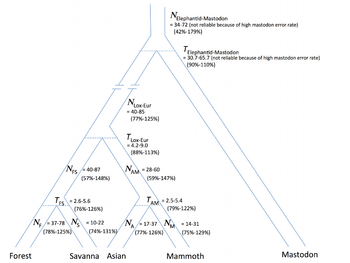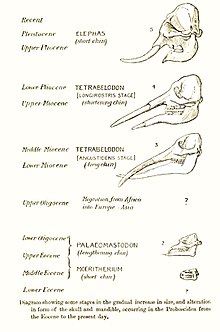en
names in breadcrumbs


Taxonomy
Elephantidae (the elephants) is the single family with living representatives in the mammal order Proboscidea. Wittemyer (2011) recognized three living elephant species: Asian Elephant (Elephas maximus), African Forest Elephant (Loxodonta cyclotis) and African Savanna Elephant (Loxodonta africana). However, Wittemyer notes that some authorities believe just a single African Elephant species should be recognized, with the forest and savanna forms recognized only as subspecies. African Savanna Elephants are the largest terrestrial animals on Earth.
Morphology
The most distinctive feature of elephantids and their extinct proboscidean relatives is the trunk, which is derived from the nose and upper lip. The African Elephant has two fingerlike projections at the end of its trunk whereas the Asian Elephant has just one. The trunk is very powerful, but also very sensitive and its opposable lips can grasp and manipulate very small items such as single nuts. In addition to manipulating objects, the trunk is also used for breathing, olfaction, touch, and sound production.
The ivory tusks of elephants are enlarged second incisors. Both male and female African Elephants have fully developed tusks, although tusk size varies geographically (in Asian Elephants, only males have fully developed tusks). In some areas, selection from hunting pressure by humans appears to have resulted in decreased average tusk size and an increase in the frequency of tusklessness.
The large ears of African Elephants play an important role in thermoregulation.
African and Asian Elephants differ in numerous ways, including body size, absolute and relative size and shape of ears, tusks, trunk structure, number of ribs, and number of toenails on the front and hind feet. In addition, relative to African Elephants, Asian Elephants tend to have smoother skin and more hair.
Behavior and Ecology
Elephants swim well and are able to submerge themselves and use the trunk as a breathing tube. Among the diverse communication modalities used by elephants is infrasonic communication, which elephants were discovered to utilize only in the late 20th century. The long wavelengths of infrasound are able to travel across large distances, with communication feasible across perhaps as much as 10 km under ideal conditions, although individuals can apparently be distinguished only up to one or a few kilometers. Evidence suggests that seismic signaling may also be used by elephants.
Elephants have a very complex social structure and young animals stay with their mother and her group for many years (perhaps for their entire lives). African Savanna Elephants typically stay within a few meters of their mothers for the first 4-8 years of life. Both Asian and African bulls are typically independent of their families by around 15 years (sometimes as young as six years).
Elephants spend as much as three quarters of their time feeding. Elephants both graze (feeding on grass) and browse (feedingmainly on leaves and terminal twigs of woody plants) and the diet composition may shift dramatically between wet and dry seasons. Asian Elephant diets tend to include more grass than those of African Elephants.
Elephants can thrive in habitats ranging from deserts to rainforests. They play major roles in shaping ecosystems through their consumption of shrubs and trees and as seed dispersers.
In recent times, African Elephants have been distributed from southernmost South Africa to the Sahel. In Roman times, they were present even in the northern Mediterranean region. Today, most African Elephants live in the sub-Saharan savanna and dry woodland ecoregions, but they continue to persist in desert regions such as Mali's Sahel and the Namib. In addition, they are found in dense tropical forests such as those found on East Africa's volcanos. Historically, Asian Elephants occupied a broad range in tropical Asia from Iraq, India, and Sri Lanka to Malaysia, Indonesia, and southern China. Today, they have been extirpated from more than 85% of this range and over 60% of Asian Elephants are thought to reside in India. Other remnant populations are found in Sri Lanka, Burma, Thailand, and the larger islands of the Malay Archpelago.
Elephants and Humans
The lives of elephants and humans have been intertwined for millenia. Asian Elephants were domesticated in the third millenium BC in the Indus Valley and this likely drove the first major declines of the species. Ivory has been a major focus of human-elephant interactions for thousands of years. Given that only the males of Asian Elephants bear tusks, African ivory was needed to satisfy the demand in India, China, and Japan and was being traded by the 6th century BC. The African slave trade was closely tied to the ivory trade, with slaves carrying ivory to the coast, where both were sold. Elephants were eradicated from much of west and southern Africa during this period. With the decline of the slave trade, ivory trade also declined and elephant populations are thought to have rebounded during much of the 1900s. Unfortunately, the 1970s saw a huge upsurge in the ivory trade with a devastating impact. It has been estimated that between 1979 and 1989 the African Elephant population was reduced from around 1.3 million to around half a million. Since then, there have been periods of both recovery and decline and the status of African Elephants remains precarious. As large-scale agriculture has increased in Africa since the 1980s, human-elephant conflicts over crop-raiding have increased. Asian Elephant populations have continued to decline as a result of both the ivory trade and habitat loss/range reduction. Although young elephants can fall prey to Tigers (in Asia) and Lions (in Africa), adult elephants are safe from predators except for humans.
At one time, elephants ranged over much of Africa and southern Asia and into the Middle East. Demand for ivory by the Roman Empire is thought to have led to the eradication of African Elephants from the northern Sahara and Asian Elephants from the Middle East. Elephant populations in both Africa and Asia declined with the increased demand for ivory (notably, for piano keys in the 1800s and 1900s). Range reduction and fragmentation poses a serious threat to the long-term viability of elephant populations in both Africa and Asia. From the vantage point of the early decades of the 21st century, only in southern Africa do elephant populations appear relatively secure, but elephants have shown themselves to be highly adapable and with adequate protection there is still hope for recovery over much of their current range. If the ivory trade increases, this will pose a great threat to remaining elephant populations, especially in light of the political instability in many of the countries in which elephants persist. Counterbalancing these threats, however, is the growing economic importance of ecotourism in many countries with elephants.
(Wittemeyer 2011 and references therein)
Source: United States Department of Agriculture Animal Welfare Information Center
see alsohttp://www.nal.usda.gov/awic/pubs/elephants/elephants2.htm
AWIC Resource Series No. 18 - April 2003
Updated by Information Resources on Elephants, 2010
Compiled by: Richard L. Crawford, D.V.M.,D'Anna Jensen, B.S., LATG, &Tim Allen, M.S.
Animal Welfare Information Center ,National Agricultural Library,U.S. Department of Agriculture
Published by: U. S. Department of Agriculture Agricultural Research Service
National Agricultural Library Animal Welfare Information Center
Beltsville, Maryland 20705
Contact us: http://www.nal.usda.gov/awic/contact.php
Web site: www.nal.usda.gov/awic
Published in cooperation with the Virginia-Maryland Regional College of Veterinary Medicine
New Phylogenetic Analysis of the Family Elephantidae Based on Cranial-Dental Morphology
Nancy E. Todd
Article first published online: 20 NOV 2009
DOI: 10.1002/ar.21010
Copyright © 2009 Wiley-Liss, Inc.
The Anatomical Record Volume 293, Issue 1, pages 74–90, January 2010
Abstract: In 1973, Vincent Maglio published a seminal monograph on the evolution of the Elephantidae, in which he revised and condensed the 100+ species named by Henry Fairfield Osborn in 1931. Michel Beden further revised the African Elephantidae in 1979, but little systematic work has been done on the family since this publication. With addition of new specimens and species and revisions of chronology, a new analysis of the phylogeny and systematics of this family is warranted. A new, descriptive character dataset was generated from studies of modern elephants for use with fossil species. Parallel evolution in cranial and dental characters in all three lineages of elephants creates homoplastic noise in cladistic analysis, but new inferences about evolutionary relationships are possible. In this analysis, early Loxodonta and early African Mammuthus are virtually indistinguishable in dental morphology. The Elephas lineage is not monophyletic, and results from this analysis suggest multiple migration events out of Africa into Eurasia, and possibly back into Africa. New insight into the origin of the three lineages is also proposed, with Stegotetrabelodon leading to the Mammuthus lineage, and Primelephas as the ancestor of Loxodonta and Elephas. These new results suggest a much more complex picture of elephantid origins, evolution, and paleogeography. Anat Rec, 2010. © 2009 Wiley-Liss, Inc.
Elephantidae is a family of large, herbivorous proboscidean mammals collectively called elephants and mammoths. These are large terrestrial mammals with a snout modified into a trunk and teeth modified into tusks. Most genera and species in the family are extinct. Only two genera, Loxodonta (African elephants) and Elephas (Asian elephants), are living.
The family was first described by John Edward Gray in 1821,[4] and later assigned to taxonomic ranks within the order Proboscidea. Elephantidae has been revised by various authors to include or exclude other extinct proboscidean genera.
Elephantids are distinguished from more primitive proboscideans like gomphotheres by their teeth, which have parallel lophs (homologous to the cusp pairs of more primitive proboscideans) bound by cement, allowing them to become more hypsodont (high-crowned) and more efficient in consuming grass.[5]
Tooth of Mammut americanum (Mammutidae)
Molar of Gomphotherium angustidens, a "trilophodont gomphothere"
Molar of Anancus, a "tetralophodont gomphothere"
Molar of a modern African bush elephant (Loxodonta africana)

Scientific classification of Elephantidae taxa embraces an extensive record of fossil specimens, over millions of years, some of which existed until the end of the last ice age. Some species were extirpated more recently. The discovery of new specimens and proposed cladistics have resulted in systematic revisions of the family and related proboscideans.
Elephantids are classified informally as the elephant family, or in a paleobiological context as elephants and mammoths. The common name elephant primarily refers to the living taxa, the modern elephants, but may also refer to a variety of extinct species, both within this family and in others. Other members of the Elephantidae, especially members of the genus Mammuthus, are commonly called mammoths.
The family diverged from a common ancestor of the mastodons of Mammutidae. The classification of proboscideans is unstable and has been frequently revised.
The following cladogram shows the placement of the genus Mammuthus among other proboscideans, based on a 2007 study of hyoid characteristics:[2]
Elephantidae Elephantinae LoxodontiniLoxodonta (2 species) ![]()

However, a 2017 study of mitochondrial and nuclear DNA placed Palaeoloxodon as more closely related to Loxodonta (in particular, the African forest elephant) than to Elephantina.[6]
The systematics of the living subspecies and species of the modern elephants has undergone several revisions. A list of the extant Elephantidae includes:[7]

Elephantids are suggested to have evolved from African species of the "tetralophodont gomphothere" Tetralophodon.[8] The earliest members of the family, are known from the Late Miocene, around 9-10 million years ago.[9] While early members of Elephantidae had lower tusks, these were lost in later members.[10] The modern genera of elephants and mammoths had diverged from each other by the end of the Miocene. Elephantids began to migrate out of Africa during the Pliocene, with mammoths and Elephas arriving in Eurasia around 3.8-3 million years ago.[11] Around 1.5 million years ago, mammoths migrated into North America.[12] At the end of the Early Pleistocene, around 0.8 million years ago, Palaeoloxodon migrated out of Africa, becoming widespread across Eurasia.[13] Palaeoloxodon and Mammuthus became extinct during the Late Pleistocene-Holocene, with the last population of mammoths persisting on Wrangel Island until around 4,000 years ago.[14]
Elephantidae is a family of large, herbivorous proboscidean mammals collectively called elephants and mammoths. These are large terrestrial mammals with a snout modified into a trunk and teeth modified into tusks. Most genera and species in the family are extinct. Only two genera, Loxodonta (African elephants) and Elephas (Asian elephants), are living.
The family was first described by John Edward Gray in 1821, and later assigned to taxonomic ranks within the order Proboscidea. Elephantidae has been revised by various authors to include or exclude other extinct proboscidean genera.